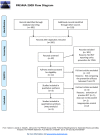Comparison between Fissure Sealant and Fluoride Varnish on Caries Prevention for First Permanent Molars: a Systematic Review and Meta-analysis
- PMID: 32055001
- PMCID: PMC7018844
- DOI: 10.1038/s41598-020-59564-5
Comparison between Fissure Sealant and Fluoride Varnish on Caries Prevention for First Permanent Molars: a Systematic Review and Meta-analysis
Abstract
The high prevalence and heavy socio-economic burden for caries of first permanent molars (FPMs) make the prevention of this disease a major public health goal. Current guidelines recommend a preference of fissure sealant (FS) over fluoride varnish (FV) based on two recent systematic reviews. However, evidences of these two studies are weak because of scarce data and some limitations. Besides, an up-to-date large scale randomized controlled trial (RCT) reported commensurate effectiveness of these two techniques. Thus, in order to more accurately compare the clinical efficacy between FS and FV on caries prevention for FPMs, we carried out this systematic review and meta-analysis. A total of 8 RCTs involving 3289 participants and 6878 FPMs fulfilled the inclusion criteria. Our meta-analysis for the first time showed that there was no statistical difference on caries incidence or occlusal DMFS increment between sealant group and fluoride varnish group at 2~3 years' follow-up. In that sense, biannual applications of FV or FS may be equally effective on caries prevention for FPMs. These results do not support routine recommendation of FS over FV, thus shedding light on current conceptions. Our findings endow clinicians with a window to reconsider the choice between these two techniques.
Conflict of interest statement
The authors declare no competing interests.
Figures




References
-
- Kassebaum NJ, et al. Global, Regional, and National Prevalence, Incidence, and Disability-Adjusted Life Years for Oral Conditions for 195 Countries, 1990-2015: A Systematic Analysis for the Global Burden of Diseases, Injuries, and Risk Factors. J. Dent. Res. 2017;96(4):380–387. doi: 10.1177/0022034517693566. - DOI - PMC - PubMed
Publication types
MeSH terms
Substances
LinkOut - more resources
Full Text Sources
Medical

